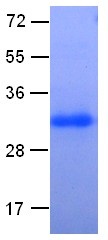RhoA Protein
| 目录: 10104 |
| 产品名称: RhoA Protein |
| 基因符号: Ras homolog gene family, member A, ARHA, ARH12, RHO12, RHOH12 |
| Source: Human, recombinant full length, His6-tag |
| Expression 种属反应性: E. coli |
| Molecular Weight: 22 kDa |
| 纯化:: >96% by SDS-PAGE |
| Introduction: Small GTPases are a super-family of cellular signaling regulators. RhoA belongs to the Rho sub-family of GTPases. Rho proteins play critical roles in many actin cytoskeleton- dependent processes including platelet aggregation, cell motility, contraction, and cytokinesis. It regulates the formation of stress fibers and focal adhesions in fibroblasts and Ca2+ sensitivity of smooth muscle contraction. |
| Amino Acid Sequence (1-193) |
| MAAIRKKLVIVGDGACGKTCLLIVFSKDQFPEVYVPTVFENYVADIEVDGKQVELALWDTAGQEDYD
RLRPLSYPDTDVILMCFSIDSPDSLENIPEKWTPEVKHFCPNVPIILVGNKKDLRNDEHTRRELAKM
KQEPVKPEEGRDMANRIGAFGYMECSAKTKDGVREVFEMATRAALQARRGKKKSGCLVL |
| Properties
|
| Physical Appearance (form): Dissolved in 20mM Tris-HCl, pH8.0, 150mM NaCl. |
| Physical Appearance (form): White or clear |
| 浓度: 1 mg/mL |
| Storage: -80°C |
| Preparation Instructions:
Centrifuge the vial before open the cap and reconstitute in water. Adding of 10 mM β-mercaptoethanol or 1 mM DTT into the solution to protect the protein is recommended and using of non-ionic detergents such as n-Dodecyl β-D-maltoside (DoDM) or polyethylene detergents (e.g. C12E10) also help to stabilize the protein. Avoid repeated freezing and thawing after reconstitution. The purity of His-tagged RhoA was determined by SDS- PAGE and Coomassie Brilliant Blue Staining. |
 References:
References:
1. Canman, J. C. et al., Science 322: 1543-1546, 2008.
2. Guilluy, C. et al., Nature Med. 16: 183-190, 2010.
3. Machacek, M. et al., Nature 461: 99-103, 2009 4. Nakamura, M. et al., Invest. Ophthal. Vis. Sci. 42: 941-947, 2001.
5. Rao, P. V. et al., Invest. Ophthal. Vis. Sci. 42: 1029-1037, 2001.
6. Valderrama, F. et al., Science 311: 377-381, 2006.
7. Wang, H.-R. et al., Science 302: 1775-1779, 2003.
8. Wu, K. Y. et al., Nature 436: 1020-1024, 2005.
9. Yoshida, S.et al., Science 313: 108-111, 2006.





 References:
1. Canman, J. C. et al., Science 322: 1543-1546, 2008.
2. Guilluy, C. et al., Nature Med. 16: 183-190, 2010.
3. Machacek, M. et al., Nature 461: 99-103, 2009 4. Nakamura, M. et al., Invest. Ophthal. Vis. Sci. 42: 941-947, 2001.
5. Rao, P. V. et al., Invest. Ophthal. Vis. Sci. 42: 1029-1037, 2001.
6. Valderrama, F. et al., Science 311: 377-381, 2006.
7. Wang, H.-R. et al., Science 302: 1775-1779, 2003.
8. Wu, K. Y. et al., Nature 436: 1020-1024, 2005.
9. Yoshida, S.et al., Science 313: 108-111, 2006.
References:
1. Canman, J. C. et al., Science 322: 1543-1546, 2008.
2. Guilluy, C. et al., Nature Med. 16: 183-190, 2010.
3. Machacek, M. et al., Nature 461: 99-103, 2009 4. Nakamura, M. et al., Invest. Ophthal. Vis. Sci. 42: 941-947, 2001.
5. Rao, P. V. et al., Invest. Ophthal. Vis. Sci. 42: 1029-1037, 2001.
6. Valderrama, F. et al., Science 311: 377-381, 2006.
7. Wang, H.-R. et al., Science 302: 1775-1779, 2003.
8. Wu, K. Y. et al., Nature 436: 1020-1024, 2005.
9. Yoshida, S.et al., Science 313: 108-111, 2006. 





